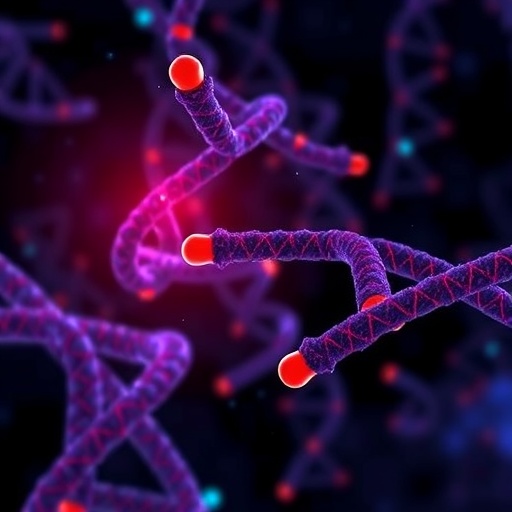The quest for precise prognostic biomarkers in cancer has led researchers to explore the multifaceted roles of the Rho GTPase-activating protein (RhoGAP) family, a group of proteins integral to cellular signaling and function. Recently, ARHGAP11A, a key member of this family, has been thrust into the spotlight following a comprehensive pan-cancer study that underscores its critical involvement in cancer biology, particularly in DNA damage response and tumor immunity. This discovery paves the way for novel insights into tumor progression and potential therapeutic interventions.
RhoGAPs regulate the activity of Rho GTPases—molecular switches that orchestrate cytoskeletal dynamics, motility, and cellular proliferation. Tight regulation of these proteins ensures proper cellular behavior and development. Despite their importance, the specific contributions of individual RhoGAPs in oncogenesis and tumor progression have remained enigmatic. The recent study, leveraging vast datasets from The Cancer Genome Atlas (TCGA), has now elucidated the distinctive overexpression pattern and functional implications of ARHGAP11A across diverse cancer types.
Analyzing over 10,000 samples spanning 33 different tumor types, researchers identified ARHGAP11A as the most prominently upregulated RhoGAP, with significant elevation in tumor tissue compared to normal counterparts. This widespread overexpression hints at a universal role for ARHGAP11A in the cancer landscape, transcending tissue-specific boundaries. Such a pervasive pattern bolsters its candidacy as a biomarker with broad applicability.
Delving deeper into ARHGAP11A’s role, the study connected its expression to DNA repair mechanisms, pivotal for maintaining genomic integrity. Cancer cells often exploit DNA repair pathways to survive genotoxic stress, including that inflicted by radiation and chemotherapy. Enhanced ARHGAP11A levels correlated strongly with markers of DNA repair activity, suggesting that it may facilitate tumor resilience by supporting effective DNA damage response (DDR).
Furthermore, the research delineated a positive association between ARHGAP11A expression and tumor mutational burden (TMB), a metric increasingly recognized for predicting responsiveness to immune checkpoint inhibitors. Elevated TMB typically signals a higher neoantigen landscape, potentially making tumors more immunogenic. However, this perceived susceptibility contrasts with observations of heightened regulatory T cell (Treg) infiltration linked to ARHGAP11A expression, which is known to temper anti-tumor immune responses. The juxtaposition of these findings reveals a complex interplay where ARHGAP11A may contribute to an immunosuppressive tumor microenvironment even amidst high TMB.
Survival analyses underscored the clinical relevance of ARHGAP11A, revealing that patients with tumors exhibiting high expression levels faced poorer outcomes across multiple cancer types. This strong prognostic value elevates ARHGAP11A from a molecular curiosity to a potential clinical tool, capable of informing risk stratification and therapeutic decisions.
Intriguingly, the study uncovered a functional liaison between ARHGAP11A and checkpoint kinase 1 (CHK1), a central regulator of DNA damage checkpoints. The positive correlation between their expression profiles implies cooperative dynamics in sustaining cancer cell viability under genotoxic stress. Functional assays substantiated this link, demonstrating that ARHGAP11A imparts resistance to CHK1 inhibitors, agents that otherwise abrogate DNA repair-driven survival pathways.
The resistance conferred by ARHGAP11A to CHK1-targeted therapies introduces a significant hurdle to the efficacy of DDR-targeting drugs. Understanding this resistance mechanism provides a roadmap for combination therapies that could overcome tumor adaptability—perhaps by simultaneously targeting ARHGAP11A and CHK1, thereby dismantling the cancer cells’ repair arsenal.
From a therapeutic standpoint, ARHGAP11A emerges as a dual-faceted target: dampening DNA repair to sensitize tumors to DNA-damaging agents, and modulating immune cell infiltration to restore anti-tumor immunity. The latter aspect is particularly tantalizing, given the current momentum in immuno-oncology, where disrupting immunosuppressive niches is a cornerstone of treatment innovation.
On the technological front, the research harnessed cutting-edge bioinformatics alongside single-cell sequencing, western blotting, and colony formation assays to unravel ARHGAP11A’s multifaceted implications. This integrative approach ensured a robust validation of findings, linking genomic data to functional cellular outcomes and clinical significance.
The overarching implication of this work is a refined understanding of how aberrant regulation of a single RhoGAP family member can orchestrate a cancer-supportive milieu, intertwining DNA repair proficiency with immune escape. The universality of ARHGAP11A’s overexpression across tumor types amplifies its potential impact, suggesting broad translational relevance.
Moving forward, detailed mechanistic studies are warranted to dissect the molecular pathways through which ARHGAP11A modulates CHK1 activity and Treg recruitment. Such insights would be invaluable in refining therapeutic targets and designing next-generation anti-cancer strategies.
Moreover, clinical evaluations incorporating ARHGAP11A as a biomarker could enhance precision medicine paradigms, allowing oncologists to predict treatment responses and tailor interventions that preempt resistance mechanisms rooted in DNA repair and immune modulation.
In summary, ARHGAP11A represents a paradigm shift in our understanding of the RhoGAP family’s involvement in cancer. By bridging DNA damage response with immunological facets within the tumor microenvironment, it provides a promising beacon for prognostic assessment and therapeutic targeting. The implications of this discovery resonate far beyond basic science, heralding new frontiers in the battle against cancer.
As researchers continue to unravel the complexities of tumor biology, ARHGAP11A stands out not merely as a marker but as a potential Achilles’ heel in malignancies worldwide. Its pivotal role in enabling cancer cell survival amidst hostile conditions challenges the field to innovate smarter, multifaceted therapies that can outmaneuver tumor adaptation and improve patient outcomes.
The convergence of molecular biology, genomics, and immunology in this study exemplifies the future trajectory of cancer research—a journey toward comprehensive profiling and tailored intervention. ARHGAP11A, once a relatively obscure member of a large protein family, now beckons for focused scientific and clinical attention, symbolizing the relentless pursuit of breakthroughs in oncology.
Subject of Research: The investigation of ARHGAP11A’s role in cancer prognosis, DNA damage response, and tumor immunity across multiple cancer types.
Article Title: ARHGAP11A, a member of Rho GTPase activating protein family, as a prognostic biomarker linked to DNA damage response across pan-cancer.
Article References:
Tan, K., Wu, Y., Zhang, J. et al. ARHGAP11A, a member of Rho GTPase activating protein family, as a prognostic biomarker linked to DNA damage response across pan-cancer. BMC Cancer 25, 1639 (2025). https://doi.org/10.1186/s12885-025-15106-8
Image Credits: Scienmag.com
DOI: https://doi.org/10.1186/s12885-025-15106-8




